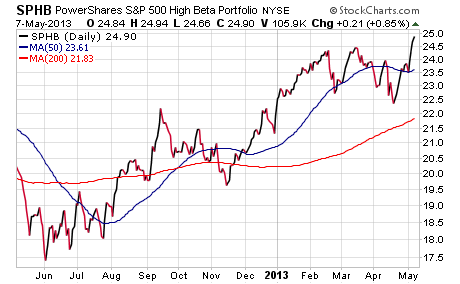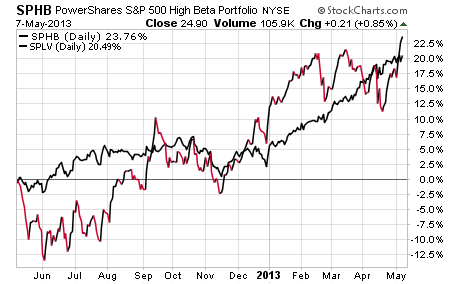Much has been made about the inflow of capital into low volatility ETFs and defensive sectors such as the PowerShares S&P 500 Low Volatility Portfolio (SPLV) and the iShares MSCI U.S. Minimum Volatility ETF USMV. I personally think that these are excellent vehicles for investors who are seeking long-term capital appreciation with minimal price fluctuations. These funds have captured billions of dollars in new assets over the last several years, and their returns have been on par or better than the SPDR S&P 500 ETF SPY. Over the last 12 months, SPLV has gained 22.97% and USMV has added 20.70%, while SPY has returned 20.71% through 5/6/13 (with dividends reinvested).
However, I also want to look at the other side of the coin to determine if there is enough alpha being provided in the "high beta" ETF category to warrant exposure to these funds as well. The biggest name is this space is the PowerShares S&P 500 High Beta Portfolio SPHB. This fund is virtually the polar opposite of SPLV in that it contains 100 stocks from the S&P 500 Index with the highest sensitivity to market movements. The index does a 12 month look back to determine which stocks have the most beta to be included in the ETF. Beta is a measure of relative risk and is the rate of change of a security's price.

As you can imagine the price fluctuations of this fund can get quite volatile, so investors should be mentally prepared to handle the ups and downs. The top three sectors in SPHB are financials (26%), technology (21%), and energy (18%) which generally tend to contain more active and heavily traded stocks.
Over the last year, SPHB has returned 22.47%, which closely resembles the gains of SPLV, but a comparison of these two ETFs on the chart tells an entirely different story. The price trend in SPHB is much more erratic and tends to go through periods of steep peaks and valleys. SPLV, on the other hand, is more consistent and has fewer fluctuations.

I would have expected that given the higher risk profile of investing in SPHB, the end result would have been much better performance than its peers over the last year. The trend towards more defensive sectors such as utilities, healthcare, and consumer staples has clearly been a drag on the cyclical stocks that comprise this ETF.
Another factor that investors should consider is that SPLV is currently yielding 2.80% and pays dividends monthly, which may be more suitable for an income oriented portfolio. While SPHB only yields 0.83% and distributes income quarterly.
Over time, I think that SPHB can add alpha to an aggressive stock investors' portfolio in the right market environment. But for now, the rising tide is lifting all ships in the harbor, which is why these ETFs are so correlated in their performance. The ultimate decision to invest in either of these funds should be based on your risk tolerance and comfort with the underlying sector exposure of the companies that comprise the index.
Disclaimer: David Fabian, Fabian Capital Management, and/or its clients may hold positions in the ETFs and mutual funds mentioned above. The commentary does not constitute individualized investment advice. The opinions offered herein are not personalized recommendations to buy, sell or hold securities.
© 2025 Benzinga.com. Benzinga does not provide investment advice. All rights reserved.
Trade confidently with insights and alerts from analyst ratings, free reports and breaking news that affects the stocks you care about.